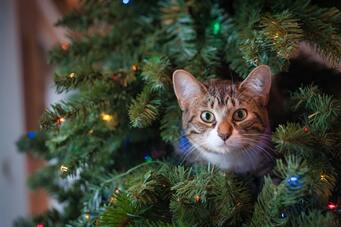Laurie Anne Walden, DVM  Pancreatitis, or inflammation of the pancreas, is common in dogs and cats. Although some cases are relatively mild, pancreatitis is painful and can cause severe disease and even death. Pancreatitis can be triggered by eating a high-fat meal or table scraps, so be very cautious about sharing holiday food with your pets. Pancreatitis is categorized as acute (a short course of disease that can be reversed) or chronic (long-term disease caused by permanent damage to pancreatic cells). These categories can overlap. Animals with repeated episodes of acute pancreatitis can develop chronic pancreatitis, and animals with chronic pancreatitis can have flares of acute disease. In cats, the chronic form is more common than the acute form.[1] The pancreas, which is located near the stomach and small intestine, produces digestive enzymes and insulin. Because of the anatomic location and functions of the pancreas, pancreatic disease doesn’t always happen in isolation. Diseases of the liver, bile duct, and small intestine affect the pancreas and vice versa. In cats, simultaneous inflammation of the liver, small intestine, and pancreas is called triaditis.[2] Chronic pancreatitis is associated with diabetes mellitus and deficiency of digestive enzymes. Causes The cause of pancreatitis in dogs and cats is often not found. However, some risk factors make pancreatitis more likely:
Symptoms The symptoms of pancreatitis vary according to disease severity and are not specific; many disorders can cause the same symptoms. Symptoms are usually more severe with acute pancreatitis than with chronic pancreatitis. Other disorders that accompany pancreatitis also contribute to the symptoms. These are some of the symptoms of acute pancreatitis:
The symptoms of chronic pancreatitis are often vague and can be mistaken for other disorders. Animals with chronic pancreatitis might have these symptoms:
Diagnosis Diagnosing pancreatitis can be tricky, especially in animals with vague symptoms or multiple organ systems affected. Baseline bloodwork and urinalysis don’t necessarily give a diagnosis but help assess the patient’s overall health and reveal associated disorders. A diagnosis of pancreatitis is typically made with a combination of blood tests for pancreas-specific factors (like serum amylase, serum lipase, canine and feline pancreas-specific lipase, pancreatic lipase immunoreactivity, and trypsin-like immunoreactivity) and ultrasonography of the abdomen.[4] Treatment Animals with acute pancreatitis usually need to stay in the hospital for at least a few days. Treatment can include intravenous fluids, pain management, antiemetics to control vomiting, tube feeding, possibly antibiotics, treatment of the underlying cause (if known), and treatment of associated disorders. Patients are monitored closely for complications like organ failure and blood clotting disorders. Animals with recurrent acute pancreatitis, chronic pancreatitis, or triaditis might need long-term diet modification.[2,5] Prognosis The prognosis depends on disease severity. Patients with mild disease tend to recover well, but the prognosis is guarded for animals with severe pancreatitis. References 1. Watson P. Pancreatitis in dogs and cats: definitions and pathophysiology. J Small Anim Pract. 2015;56(1):3-12. doi:10.1111/jsap.12293 2. Simpson KW. Pancreatitis and triaditis in cats: causes and treatment. J Small Anim Pract. 2015;56(1):40-49. doi:10.1111/jsap.12313 3. Lem KY, Fosgate GT, Norby B, Steiner JM. Associations between dietary factors and pancreatitis in dogs. J Am Vet Med Assoc. 2008;233(9):1425-1431. doi:10.2460/javma.233.9.1425 4. Xenoulis PG. Diagnosis of pancreatitis in dogs and cats. J Small Anim Pract. 2015;56(1):13-26. doi:10.1111/jsap.12274 5. Steiner JM. Pancreatitis in dogs and cats. Merck Veterinary Manual. Updated October 2020. Accessed December 22, 2020. https://www.merckvetmanual.com/digestive-system/the-exocrine-pancreas/pancreatitis-in-dogs-and-cats Photo by Sebastian Coman Travel Laurie Anne Walden, DVM  Happy holidays! Keep your cat safe from these common household dangers when you’re preparing for the season. Strings Ribbons, tinsel, yarn, twine, fishing line, thread, garland, and other long strings are hazardous if swallowed. A string in the digestive tract can cause a linear foreign body obstruction. Cats with digestive tract obstruction need surgery to prevent serious damage to the intestines. Keep this danger in mind when choosing holiday decorations. Wide ribbons might be less of a swallowing hazard than narrow ribbons. Shiny Objects Tinsel is especially attractive to cats because it’s sparkly, so a long string of tinsel is an intestinal obstruction waiting to happen. Watch out for glass ornaments that can cut paws if they mysteriously land on the floor and break. Expect that your cats will treat all glittery and shiny items as cat toys and decorate accordingly. Wood and fabric ornaments are safer than glass ornaments in a household with cats. The Tree With Christmas trees, the goal is to prevent damage to your cat and damage to property. Christmas tree dangers to cats include tree water (might contain preservatives or pesticides), swallowed pine needles, broken or swallowed ornaments, electrical wires, and being hit by a falling tree. If your cat ignores the tree, you might not need to do anything more than keep breakable ornaments on high branches, cat-safe (or no) ornaments on low branches, and a close eye on your cat when he’s in the room with the tree. But if your cat is young, curious, adventurous, or new to your home, assume he’ll want to climb the Christmas tree. The safest approach is to either not have a tree or to close the door and keep the cat out of the room. If your cat has access to the tree, use a sturdy base and secure the tree to the ceiling or walls so it can’t tip over. Don’t use any breakable ornaments if your cat is a climber. To prevent electrocution, keep the tree lights unplugged when you’re not watching your cat. Try giving your cat a more attractive alternative, like a high perch and new toys or a cat Christmas tree (maybe made from a cardboard box). You could try bitter orange spray or an unappealing floor covering around the tree (aluminum foil, adhesive paper with the sticky side up, or a nonslip rug gripper with the pointy side up), but don’t count on deterrents like these to keep your cat out of the tree. Other Plants Lilies are among the most dangerous plants for cats; don’t bring them in your house at all if you have a cat. Holly, mistletoe, and amaryllis are toxic to cats to some degree. Poinsettias are mildly toxic to cats. Flames and Electrical Wires Cats like to push things off tables and are curious about new items in their living space. Don’t leave a cat alone with lit candles, which are a fire hazard if knocked over. Cats will also chew on electrical cords, so cover the cords and keep lights and other electrical decor unplugged when not in use. Human Food Onions, leeks, chives, and garlic are toxic to cats. Chocolate, alcohol, raw bread dough, fatty food, raw eggs, raw meat, and bones are also dangerous for cats. See the blog post on human foods that are toxic to pets for more information. If you’d like to share some of your holiday meal with your cat, see the post on Thanksgiving foods that are safe for dogs and cats. Photo by Jessica Lewis |
AuthorLaurie Anne Walden, DVM Categories
All
Archives
June 2024
The contents of this blog are for information only and should not substitute for advice from a veterinarian who has examined the animal. All blog content is copyrighted by Mallard Creek Animal Hospital and may not be copied, reproduced, transmitted, or distributed without permission.
|
- Home
- About
- Our Services
- Our Team
-
Client Education Center
- AKC: Spaying and Neutering your Puppy
- Animal Poison Control
- ASPCA Poisonous Plants
- AVMA: Spaying and Neutering your pet
- Biting Puppies
- Boarding Your Dog
- Caring for the Senior Cat
- Cats and Claws
- FDA warning - Bone treats
- Force Free Alliance of Charlotte Trainers
- Getting your Cat to the Vet - AAFP
- Holiday Hazards
- How To Feed Cats for Good Health
- How to Get the Most Out of your Annual Exam
- Indoor Cat Initiative - OSU
- Introducing Your Dog to Your Baby
- Moving Your Cat to a New Home
- Muzzle Training
- Osteoarthritis Checklist for Cats
- What To Do When You Find a Stray
- Our Online Store
- Dr. Walden's Blog
- Client Center
- Contact
- Cat Enrichment Month 2024
|
Office Hours
Monday through Friday 7:30 am to 6:00 pm
|
Mallard Creek Animal Hospital
2110 Ben Craig Dr. Suite 100
|
Site powered by Weebly. Managed by IDEXX Laboratories

 RSS Feed
RSS Feed